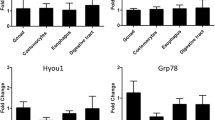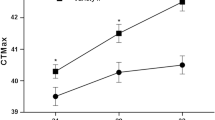Abstract
Every organism responds to heat stress by synthesizing a group of evolutionarily conserved proteins called the heat-shock proteins (HSPs) that, by acting as molecular chaperones, protect the cell against the aggregation of denatured proteins and play a significant role in adaptation to temperature. The present study aimed to investigate the critical thermal maxima (CTMax) and the expression of HSP70 in different tissues (gill, brain, muscle and liver) of an endemic catfish Horabagrus brachysoma acclimated at either 20 or 30°C for 30 days. To understand the HSP70 response, fish acclimated to the two temperatures were exposed to preset temperatures (26, 30, 34, 36 and 38°C for 20°C acclimated fish and 32, 34, 36, 38 and 40°C for 30°C acclimated fish) for 2 h, followed by 1 h recovery at their respective acclimation temperatures. The HSP70 levels in the gill, brain, muscle and liver tissues were determined by Western blotting of one-dimensional sodium dodecyl sulphate–polyacrylamide gel electrophoresis. A significant (P < 0.05) increase in the CTMax values was observed for fish acclimated at 30°C (41.86 ± 0.39°C) than those acclimated at 20°C (39.13 ± 0.18°C). HSP70 was detected in all the tissues with the highest level in the liver followed by intermediate levels in muscle and brain, and lowest level in gill tissue, irrespective of the acclimation temperatures (20 or 30°C). The HSP70 levels were significantly higher (P < 0.05) in the tissues of fish acclimated at 30°C than those acclimated at 20°C. The mean induction temperature of HSP70 in all the tissues of fish acclimated at either 20 or 30°C was 30 and 34°C, respectively. The optimum temperature for HSP70 induction in all the tissues of fish acclimated at 20°C was 36°C, whereas for fish acclimated at 30°C was 36°C for gill and 38°C for brain, muscle and liver. Decreased levels of HSP70 were noted in all the tissues of fish when exposed to temperatures that exceeded the optimum temperatures for HSP70 inductions. Overall results indicated that acclimation temperature influences both temperature tolerance and induction of HSP70 in H. brachysoma.



Similar content being viewed by others
References
Anvar Ali P, Raghavan R, Prasad G (2007) Threatened fishes of the world: Horabagrus brachysoma (gunther, 1864) (bagridae). Environ Biol Fishes 78:221. doi:10.1007/s10641-006-0022-4
Arkush KD, Cherr GN, Clegg JS (2008) Induced thermotolerance and tissue Hsc70 in juvenile coho salmon, Oncorhynchus kisutch. Acta Zool 89:331–338. doi:10.1111/j.1463-6395.2008.00321.x
Barua D, Heckathorn SA (2004) Acclimation of the temperature set-points of the heat-shock response. J Therm Biol 29:185–193. doi:10.1016/j.jtherbio.2004.01.004
Beitinger TL, Bennett WA (2000) Quantification of the role of acclimation temperature in temperature tolerance of fishes. Environ Biol Fishes 58:277–288. doi:10.1023/A:1007618927527
Beitinger TL, Bennett WA, McCauley RW (2000) Temperature tolerances of North American freshwater fishes exposed to dynamic changes in temperature. Environ Biol Fish 58:237–275. doi:10.1023/A:1007676325825
Bhat A (2001) New report of the species, Horabagrus brachysoma in the Uttara Kannada district of Karnataka. J Bombay Nat Hist Soc 98:294–296
Bradford MM (1976) A rapid and sensitive method for the quantitation of microgram quantities of protein utilizing the principle of protein-dye binding. Anal Biochem 72:248–254. doi:10.1016/0003-2697(76)90527-3
Brett JR (1971) Energetic responses of salmon to temperature. A study of some thermal relations in the physiology and freshwater ecology of sockeye salmon (oncorhynchus nerkd). Am Zool 11:99–113. doi:10.1093/icb/11.1.99
Buckley BA, Owen M, Hofmann GE (2001) Adjusting the thermostat: the threshold induction temperature for the heat-shock response in intertidal mussels (genus Mytilus) changes as a function of thermal history. J Exp Biol 204:3571–3579
Bukau B, Horwich AL (1998) The Hsp70 and Hsp60 chaperone machines. Cell 92:351–366. doi:10.1016/S0092-8674(00)80928-9
Chatterjee N, Pal AK, Manush SM, Das T, Mukherjee SC (2004) Thermal tolerance and oxygen consumption of labeo rohita and cyprinus carpio early fingerlings acclimated to three different temperatures. J Therm Biol 29:265–270. doi:10.1016/j.jtherbio.2004.05.001
Clegg JS, Uhlinger KR, Jackson SA, Cherr GN, Rifkin E, Friedman CS (1998) Induced thermotolerance and the heat shock protein-70 family in the pacific oyster Crassostrea gigas. Mol Mar Biol Biotechnol 7:21–30
Craig EA, Gross CA (1991) Is hsp70 the cellular thermometer? Trends Biochem Sci 16:135–140. doi:10.1016/0968-0004(91)90055-Z
Currie S, Moyes CD, Tufts BL (2000) The effects of heat shock and acclimation temperature on hsp70 and hsp30 mRNA expression in rainbow trout: in vivo and in vitro comparisons. J Fish Biol 56:398–408. doi:10.1111/j.1095-8649.2000.tb02114.x
Dalvi RS, Pal AK, Tiwari LR, Das T, Baruah K (2009) Thermal tolerance and oxygen consumption rates of the catfish Horabagrus brachysoma (Günther) acclimated to different temperatures. Aquaculture 295:116–119. doi:10.1016/j.aquaculture.2009.06.034
Das T, Pal AK, Chakraborty SK, Manush SM, Chatterjee N, Mukherjee SC (2004) Thermal tolerance and oxygen consumption of Indian major carps acclimated to four temperatures. J Therm Biol 29:157–163. doi:10.1016/j.jtherbio.2004.02.001
Das T, Pal AK, Chakraborty SK, Manush SM, Chatterjee N, Apte SK (2006) Metabolic elasticity and induction of heat shock protein 70 in Labeo rohita acclimated to three temperatures. Asian Aust J Anim Sci 19:1033–1039
Debnath D, Pal AK, Sahu NP, Baruah K, Yengkokpam S, Das T, Manush SM (2006) Thermal tolerance and metabolic activity of yellowtail catfish Pangasius pangasius (hamilton) advanced fingerlings with emphasis on their culture potential. Aquaculture 258:606–610. doi:10.1016/j.aquaculture.2006.04.037
Dietz T (1994) Acclimation of the threshold induction temperatures for 70-kDa and 90-kDa heat shock proteins in the fish Gillichthys mirabilis. J Exp Biol 188:333–338
Dietz TJ, Somero GN (1992) The threshold induction temperature of the 90-kDa heat shock protein is subject to acclimatization in eurythermal goby fishes (genus Gillichthys). Proc Natl Acad Sci USA 89:3389–3393
Dietz TJ, Somero GN (1993) Species- and tissue-specific synthesis patterns for heat-shock proteins HSP70 and HSP90 in several marine teleost fishes. Physiol Zool 66:863–880
DuBeau SF, Pan F, Tremblay GC, Bradley TM (1998) Thermal shock of salmon in vivo induces the heat shock protein hsp 70 and confers protection against osmotic shock. Aquaculture 168:311–323. doi:10.1016/S0044-8486(98)00358-5
Dyer SD, Dickson KL, Zimmerman EG (1991) Tissue-specific patterns for heat-shock proteins and thermal tolerance of the fathead minnow (Pimephales prometas). Can J Zool 69:2021–2027
Ekambaram P (2010) Physiological adaptations of stressed fish to polluted environments: role of heat shock proteins. In: Whitacre DM (ed) Reviews of environmental contamination and toxicology, vol 206. Springer, New York, pp 1–27. doi:10.1007/978-1-4419-6260-7_1
Hazel JR, Prosser CL (1974) Molecular mechanisms of temperature compensation in poikilotherms. Physiol Rev 54:620–677
Iwama GK, Thomas PT, Forsyth RB, Vijayan MM (1998) Heat shock protein expression in fish. Rev Fish Biol Fish 8:35–56. doi:10.1023/A:1008812500650
Kregel KC (2002) Molecular biology of thermoregulation: invited review: heat shock proteins: modifying factors in physiological stress responses and acquired thermotolerance. J Appl Physiol 92:2177–2186. doi:10.1152/japplphysiol.01267.2001
Laemmli UK (1970) Cleavage of structural proteins during the assembly of the head of bacteriophage T4. Nature 227:680–685. doi:10.1038/227680a0
Lund SG, Ruberté MR, Hofmann GE (2006) Turning up the heat: the effects of thermal acclimation on the kinetics of hsp70 gene expression in the eurythermal goby, Gillichthys mirabilis. Comp Biochem Physiol A 143:435–446. doi:10.1016/j.cbpa.2005.12.026
Molur S, Walker S (2001) Conservation assessment and management plan. Workshop report by Zoo Outreach Organization. CBSG, Coimbatore Indian Edition
Morimoto RI (1993) Cells in stress: transcriptional activation of heat shock genes. Science 259:1409–1410. doi:10.1126/science.8451637
Morimoto RI, Santoro MG (1998) Stress-inducible responses and heat shock proteins: new pharmacologic targets for cytoprotection. Nat Biotech 16:833–838. doi:10.1038/nbt0998-833
Moseley PL (1997) Heat shock proteins and heat adaptation of the whole organism. J Appl Physiol 83:1413–1417
Nakano K, Iwama GK (2002) The 70 kDa heat shock protein response in two intertidal sculpins, Oligocottus maculosus and O. snyderi: relationship of hsp70 to thermal tolerance. Comp Biochem Physiol A 133: 79–94. doi:10.1016/S1095-6433(02)00115-0
Norris C, di Iorio P, Schultz R, Hightower L (1995) Variation in heat shock proteins within tropical and desert species of poeciliid fishes. Mol Biol Evol 12:1048–1062
Pörtner HO (2001) Climatic change and temperature dependent biogeography: oxygen limitation of thermal tolerance in animals. Naturwissenschaften 88:137–146. doi:10.1007/s001140100216
Roberts DA, Hofmann GE, Somero GN (1997) Heat-shock protein expression in Mytilus californianus: acclimatization (seasonal and tidal-height comparisons) and acclimation effects. Biol Bull 192:309–320
Sanders BM, Martin LS, Howe SR, Nelson WG, Hegre ES, Phelps DK (1994) Tissue-specific differences in accumulation of stress proteins in Mytilus edulis exposed to a range of copper concentrations. Toxicol Appl Pharmacol 125:206–213. doi:10.1006/taap.1994.1066
Sarma K, Pal AK, Ayyappan S, Das T, Manush SM, Debnath D, Baruah K (2010) Acclimation of anabas testudineus (bloch) to three test temperatures influences thermal tolerance and oxygen consumption. Fish Physiol Biochem 36:85–90. doi:10.1007/s10695-008-9293-3
Schlesinger MJ (1990) Heat shock proteins. (minireview). J Biol Chem 265:12111–12114
Schmidt H, Posthaus H, Busato A, Wahli T, Meier W, Burkhardt-Holm P (1998) Transient increase in chloride cell number and heat shock protein expression (hsp70) in brown trout (Salmo trutta fario) exposed to sudden temperature elevation. Biol Chem 379:1227–1234. doi:10.1515/bchm.1998.379.10.1227
Selvakumar S, Geraldine P (2005) Heat shock protein induction in the freshwater prawn Macrobrachium malcolmsonii: acclimation-influenced variations in the induction temperatures for Hsp70. Comp Biochem Physiol A 140:209–215. doi:10.1016/j.cbpb.2005.01.008
Sreeraj N, Raghavan R, Prasad G (2006) The diet of Horabagrus brachysoma (gunther), an endangered bagrid catfish from Lake Vembanad (South India). J Fish Biol 69:637–642. doi:10.1111/j.1095-8649.2006.01134.x
Tomanek L, Somero GN (2002) Interspecific and acclimation induced variation in levels of heat-shock proteins 70 (hsp70) and 90 (hsp90) and heat-shock transcription factor-1 (HSF1) in congeneric marine snails (genus Tegula): implications for regulation of hsp gene expression. J Exp Biol 205:677–685
Towbin H, Staehelin T, Gordon J (1979) Electrophoretic transfer of proteins from polyacrylamide gels to nitrocellulose sheets: procedure and some applications. Proc Natl Acad Sci USA 76:4350–4354
Viant MR, Werner I, Rosenblum ES, Gantner AS, Tjeerdema RS, Johnson ML (2003) Correlation between heat-shock protein induction and reduced metabolic condition in juvenile steelhead trout (Oncorhynchus mykiss) chronically exposed to elevated temperature. Fish Physiol Biochem 29:159–171. doi:10.1023/B:FISH.0000035938.92027.81
Wang Y, Xu J, Sheng L, Zheng Y (2007) Field and laboratory investigations of the thermal influence on tissue-specific Hsp70 levels in common carp (Cyprinus carpio). Comp Biochem Physiol A 148:821–827. doi:10.1016/j.cbpa.2007.08.009
Werner I, Koger CS, Hamm JT, Hinton DE (2001) Ontogeny of the heat shock protein, hsp70 and hsp60, response and developmental effects of heat-shock in the teleost, medaka (Oryzias latipes). Environ Sci 8:13–29
Wu C (1995) Heat shock transcription factors: structure and regulation. Annu Rev Cell Dev Biol 11:441–469. doi:10.1146/annurev.cb.11.110195.002301
Acknowledgments
The first author was senior research fellow in the thermal ecology project funded by the Board of Research in Nuclear Sciences (BRNS). The authors acknowledge the financial support from BRNS, Department of Atomic Energy, Government of India (BRNS Sanction No. 99/36/22/BRNS, Grant No. 089).
Author information
Authors and Affiliations
Corresponding author
Rights and permissions
About this article
Cite this article
Dalvi, R.S., Pal, A.K., Tiwari, L.R. et al. Influence of acclimation temperature on the induction of heat-shock protein 70 in the catfish Horabagrus brachysoma (Günther). Fish Physiol Biochem 38, 919–927 (2012). https://doi.org/10.1007/s10695-011-9578-9
Received:
Accepted:
Published:
Issue Date:
DOI: https://doi.org/10.1007/s10695-011-9578-9




